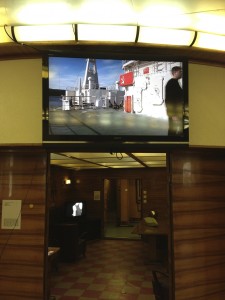
Austrian and Russian artists conquer the Arctic city of Murmansk.
What is the Bolshevik leader doing on the icebreaker which bears his name? Melting. Russian artist Maria Koshenkova shows only the right half of a bronze bust of Lenin; the left half has apparently melted into a glass puddle. All this on the table of the captain’s cabin. Between 1957 and 1989, the nuclear-powered icebreaker demonstrated Soviet greatness north of the Arctic Circle. Today it is a museum ship permanently anchored in Murmansk. Last week was the opening of a novel exhibition entitled “Icebreaker: Lenin”. In March, the show will move to the Lentos Museum in Linz, Austria.
Cooperation between Russian and Austrian bureaucrats and artists proved to be nerve-wracking. “For many here, art is supposed to be beautiful”, says Austrian artist Michael Strasser. In his video and interviews with crew members and other Murmansk inhabitants, Strasser explores the depth of local understanding of art. At the beginning he was not sure if he wanted to participate in a show on a former nuclear-powered ship in Putinist Russia but then felt: “When it comes to nuclear power, we in the West are not much better anyway.”
The icebreaker with its luxury Soviet decor is a brilliant setting and mirror for contemporary interpretations of Russian history. Isa Rosenberger’s video about the Russian exclave Brighton Beach in New York is shown in the ship’s canteen, which once also doubled as an onboard cinema. Upstairs in the officer’s dining room, Russia’s famous artist duo Igor Makarevich and Elena Elagina playfully placed ping-pong balls with quotes of the leader of the Russian revolution next to another Lenin statue.
The somewhat crazy idea of filling a post-Soviet museum ship north of the Arctic Circle with contemporary art from Austria and Russia came from Simon Mraz, cultural attaché of the Austrian embassy in Moscow. Alexander Barimov, captain of the icebreaker, wanted to cancel the show in June, when he saw some of the works. And he did forbid a few at the end. “You need to know what is possible and what not”, he said, quite content with himself late at night, when the launch party came to a happy ending.
Next March, however, Johanna and Helmut Kandl want to see their project in the Lentos Museum in its originally conceived form. The Austrian art duo wanted to put place names on the conference table with the identities of spies from East and West. But Captain Barimov would have nothing of the secret agents’ conference. He insisted of omitting the names of the spies, the place cards stand nameless “The advantage for us”, says Stella Rollig, director of Lentos, “we will have something new to offer.” And that’s a good thing, as one of the major elements of the project will be missing: the icebreaker Lenin.


